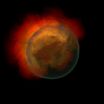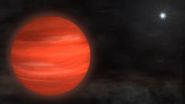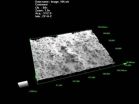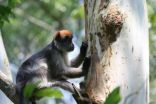(Press-News.org) Supercomputer simulations have revealed that a type of oddly dim, exploding star is probably a class of duds—one that could nonetheless throw new light on the mysterious nature of dark energy.
Most of the thousands of exploding stars classified as type Ia supernovae look similar, which is why astrophysicists use them as accurate cosmic distance indicators. They have shown that the expansion of the universe is accelerating under the influence of an unknown force now called dark energy; yet approximately 20 type Ia supernovae look peculiar.
"They're all a little bit odd," said George Jordan, a research scientist at the University of Chicago's Flash Center for Computational Science. Comparing odd type Ia supernovae to normal ones may permit astrophysicists to more precisely define the nature of dark energy, he noted.
Jordan and three colleagues, including his chief collaborator on the project, Hagai Perets, assistant professor of physics at Technion – Israel Institute of Technology, have found that the peculiar type Ia supernovae are probably white dwarf stars that failed to detonate. "They ignite an ordinary flame and they burn, but that isn't followed by a triggering of a detonation wave that goes through the star," Jordan said. These findings were based on simulations that consumed approximately two million central processing unit hours on Intrepid, the Blue Gene/P supercomputer at Argonne National Laboratory. Full details of the simulations will appear in the Astrophysical Journal Letters.
The triggering of a detonation wave is exactly what happens in normal type Ia supernovae, which incinerate white dwarfs, stars that have shrunk to Earth size after having burned most or all of their nuclear fuel. Most or all white dwarfs occur in binary systems, those that consist of two stars orbiting one another.
Faint, hard to detect
Peculiar type Ia supernovae are anywhere from 10 to 100 times fainter than normal ones, which are brighter and therefore more easily detected. Astrophysicists have estimated that they may account for approximately 15 percent of all type Ia supernovae.
The first in this class of exceptionally dim supernovae was discovered in 2002, noted Robert Fisher, assistant professor of physics at the University of Massachusetts Dartmouth, a co-author of the paper. Called SN 2002cx, it is considered the most peculiar type Ia supernova ever observed.
The dimmest of the lot, however, was discovered in 2008. "If the brightness of a standard supernova could be thought of as a single 60-watt light bulb, the brightness of this 2008 supernova would be equivalent to a small fraction of a single candle or a few dozen fireflies," Fisher noted.
Flash Center scientists have been successfully simulating type Ia supernova explosions following the gravitationally confined detonation scenario for years. In this scenario, the white dwarf begins to burn near its center. This ignition point burns outward, floating toward the surface like a bubble. After it breaks the surface, a cascade of hot ash flows around the star and collides with itself on the opposite end, triggering a detonation.
"We took the normal GCD scenario and asked what would happen if we pushed this to the limits and see what happens when it breaks," Jordan said. In the failed detonation scenario, the white dwarf experiences more ignition points that are closer to the core, which fuels more burning than in the detonation scenario.
"The extra burning causes the star to expand more, preventing it from achieving temperatures and pressures high enough to trigger detonation," noted co-author Daniel van Rossum of UChicago's Flash Center.
No incinerated star
Instead of detonating, the white dwarf remains intact, though some of the star's mass burns up and gets ejected from its surface. This failed detonation scenario looks quite similar to the peculiar type Ia explosions. The simulations resulted in phenomena that astronomers now can look for or have already found in their telescopic observations.
These phenomena include white dwarfs that display unusual compositions, asymmetric surface characteristics and a kick that sends the stars flying off at speeds of hundreds of miles per second. "This was a completely new discovery," Perets said. "No one had ever suggested that white dwarfs could be kicked at such velocities."
Normal type Ia supernovae display a relatively uniform appearance, but the asymmetric characteristics of their peculiar cousins means that the latter will often look much different from one another, depending on their viewing angle from Earth.
The asymmetric explosion also produces the kick, which is possibly powerful enough to release the white dwarf from the gravitational hold of any binary companion it may have had. This can produce a peculiar type of hyper-velocity white dwarf, the fastest of which might even escape the galaxy.
Smaller kicks might leave the binary system intact, but also push the white dwarf into a tight and highly elliptical orbit around its companion. Most white dwarfs orbiting close to their companions display a more circular orbit.
Typical white dwarfs have compositions of carbon and oxygen, yet some of the simulated ones that failed to detonate displayed heavy elements such as calcium, titanium and iron. When
the detonation fails to happen, much of the ejected mass falls back onto the surface of the white dwarf, where the heavy elements become synthesized.
"I had never heard of such strange white dwarfs," Perets said. But when he conducted a literature search, he found reports of white dwarfs with properties that an irregular composition could explain. "It is quite rare that a new model brings about so many novel predictions, and potentially solves several distinct, seemingly unrelated puzzles."
INFORMATION:
Citation: "Failed-detonation supernovae: sub-luminous low-velocity IA supernovae and their kicked remnant white dwarfs with iron-rich cores," by George C. Jordan IV, Hagai B. Perets, Robert T. Fisher, and Daniel R. van Rossum," Astrophysical Journal Letters.
Funding: U.S. Department of Energy, National Science Foundation, Harvard-Smithsonian Center for Astrophysics and the Israel Science Foundation.
Failed explosions explain most peculiar supernovae
2012-11-20
ELSE PRESS RELEASES FROM THIS DATE:
Scripps Research Institute team identifies a potential cause of Parkinson's disease
2012-11-20
LA JOLLA, CA – November 19, 2012 – Deciphering what causes the brain cell degeneration of Parkinson's disease has remained a perplexing challenge for scientists. But a team led by scientists from The Scripps Research Institute (TSRI) has pinpointed a key factor controlling damage to brain cells in a mouse model of Parkinson's disease. The discovery could lead to new targets for Parkinson's that may be useful in preventing the actual condition.
The team, led by TSRI neuroscientist Bruno Conti, describes the work in a paper published online ahead of print on November 19, ...
Astronomers pin down origins of 'mile markers' for expansion of universe
2012-11-20
COLUMBUS, Ohio – A study using a unique new instrument on the world's largest optical telescope has revealed the likely origins of especially bright supernovae that astronomers use as easy-to-spot "mile markers" to measure the expansion and acceleration of the universe.
In a paper to appear in the Astrophysical Journal, researchers describe observations of recent supernova 2011fe that they captured with the Large Binocular Telescope (LBT) using a tool created at Ohio State University: the Multi-Object Double Spectrograph (MODS).
MODS measures the frequencies and intensities ...
Smoking in pregnancy tied to lower reading scores
2012-11-20
Yale School of Medicine researchers have found that children born to mothers who smoked more than one pack per day during pregnancy struggled on tests designed to measure how accurately a child reads aloud and comprehends what they read.
The findings are published in the current issue of The Journal of Pediatrics.
Lead author Jeffrey Gruen, M.D., professor of pediatrics and genetics at Yale School of Medicine, and colleagues analyzed data from more than 5,000 children involved in the Avon Longitudinal Study of Parents and Children (ALSPAC), a large-scale study of ...
Astronomers directly image massive star's 'super-Jupiter'
2012-11-20
Astronomers using infrared data from the Subaru Telescope in Hawaii have discovered a "super-Jupiter" around the bright star Kappa Andromedae, which now holds the record for the most massive star known to host a directly imaged planet or lightweight brown dwarf companion.
Designated Kappa Andromedae b (Kappa And b, for short), the new object has a mass about 12.8 times greater than Jupiter's. This places it teetering on the dividing line that separates the most massive planets from the lowest-mass brown dwarfs. That ambiguity is one of the object's charms, say researchers, ...
Ah, that new car smell: NASA technology protects spacecraft from outgassed molecular contaminants
2012-11-20
Outgassing — the physical process that creates that oh-so-alluring new car smell — isn't healthy for humans and, as it turns out, not particularly wholesome for sensitive satellite instruments, either. But a team of NASA engineers has created a new way to protect those instruments from its ill effects.
For some people, the best part about buying a new car is its factory-fresh new car smell, a distinctive aroma created when the chemicals and residual solvents used to manufacture dashboards, car seats, carpeting and other vehicle appointments outgas and fill the cabin. ...
Some cells don't know when to stop
2012-11-20
Certain mutated cells keep trying to replicate their DNA — with disastrous results — even after medications rob them of the raw materials to do so, according to new research from USC.
New imaging techniques allowed scientists to see for the first time that while chemotherapy drugs shut down the DNA replication process of most cancer cells, so-called "checkpoint mutants" just keep chugging along, unwinding the DNA and creating damaged DNA strands that can result in the kind of abnormalities seen in cancer cells.
"Older methods suggested that these checkpoint mutants ...
NASA sees sun's 2 Prominence Eruptions
2012-11-20
VIDEO:
The Sun erupted with two prominence eruptions, one after the other over a four-hour period (Nov. 16, 2012). The action was captured in the 304 Angstrom wavelength of extreme ultraviolet...
Click here for more information.
The Sun erupted with two prominence eruptions, one after the other over a four-hour period on Nov. 16, 2012, between the hours of 1 and 5 a.m. EST. The red-glowing looped material is plasma, a hot gas made of electrically charged hydrogen and helium. ...
Beargrass, a plant of many roles, is focus of new report
2012-11-20
Beargrass is an ecologically, culturally, and economically important plant in the Western United States and, for the first time, landowners, managers, and harvesters now have a comprehensive report about the species.
The report, Natural and Cultural History of Beargrass (Xerophyllum tenax), published by the U.S. Forest Service's Pacific Northwest Research Station, identifies critical knowledge gaps and areas for future research. It also documents how changes in disturbance, including fire, may affect the species across its range.
"Beargrass is emblematic of a web of ...
Estrogenic plants linked to altered hormones, possible behavior changes in monkeys
2012-11-20
Berkeley — Eating certain veggies not only supplies key nutrients, it may also influence hormone levels and behaviors such as aggression and sexual activity, says a new study led by researchers at the University of California, Berkeley, that could shed light on the role of diet in human evolution.
The research is the first to observe the connection between plant-based estrogenic compounds, or phytoestrogens, and behavior in wild primates — in this case, a group of red colobus monkeys in Uganda.
The more the male monkeys dined on the leaves of Millettia dura, a tropical ...
Adolescents with low status among peers are more likely to become adult smokers
2012-11-20
A new study from Sweden reveals that having low peer status in adolescence is a strong risk factor for regular and heavy smoking in adulthood.
Researchers from Stockholm University in Sweden used a large database that followed the lives of more than 15,000 Swedes, mainly from the Stockholm area, from birth to middle age. The researchers isolated 2,329 people who were interviewed once at age 13 about peer status at school and again at age 32 about their smoking habits. The results indicate that the lower a young person's status is among his or her school peers, the more ...




